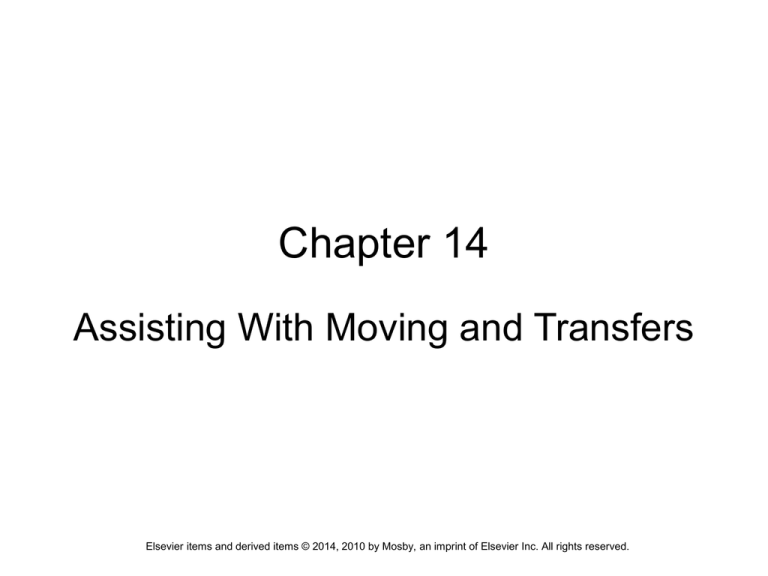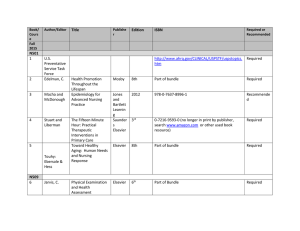
Chapter 14
Assisting With Moving and Transfers
Elsevier items and derived items © 2014, 2010 by Mosby, an imprint of Elsevier Inc. All rights reserved.
Injury Protection
To protect yourself and the person from
injury, you must use your body correctly
when:
Turning and repositioning persons
Moving persons in bed
Transferring persons to and from beds, chairs,
wheelchairs, stretchers, and toilets
To transfer a person means moving the
person from one place to another.
Elsevier items and derived items © 2014, 2010 by Mosby, an imprint of Elsevier Inc. All rights reserved.
2
Preventing Work-Related Injury
The Occupational Safety and Health
Administration (OSHA) recommends that:
Manual lifting be minimized in all cases
Manual lifting be eliminated when possible
To safely handle, move, and transfer the
person, the nurse and health team determine:
The person’s dependence level
The amount of assistance and how many staff
members are needed
The procedure to use
The equipment needed
Elsevier items and derived items © 2014, 2010 by Mosby, an imprint of Elsevier Inc. All rights reserved.
3
Protecting the Skin
Protect the person’s skin during handling,
moving, and transfer procedures.
Friction is the rubbing of one surface against
another.
Shearing is when the skin sticks to a surface
while muscles slide in the direction the body is
moving.
Elsevier items and derived items © 2014, 2010 by Mosby, an imprint of Elsevier Inc. All rights reserved.
4
Protecting the Skin, cont'd.
To reduce friction and shearing:
Roll the person.
Use friction-reducing devices.
•
•
•
•
•
•
A lift sheet (turning sheet)
A cotton drawsheet
Turning pads
Large incontinence products
Slide boards
Slide sheets
Elsevier items and derived items © 2014, 2010 by Mosby, an imprint of Elsevier Inc. All rights reserved.
5
Moving Persons in Bed
OSHA recommends the following:
For a dependence level of Code 4: Total Dependence
• A mechanical lift or friction-reducing device and at least 2 staff
members
For a dependence level of Code 3: Extensive Assistance
• A mechanical lift or friction-reducing device and at least 2 staff
members
If the person weighs less than 200 pounds
• 2 to 3 staff members and a friction-reducing device
If the person weighs more than 200 pounds
• At least 3 staff members and a friction-reducing device
Elsevier items and derived items © 2014, 2010 by Mosby, an imprint of Elsevier Inc. All rights reserved.
6
Moving Persons in Bed, cont'd.
Moving the person up in bed
You can sometimes move lightweight adults up in
bed alone:
• If they assist
• If they use a trapeze
It is best to have help and to use an assist device.
Two or more staff members are needed to move
the following persons up in bed:
• Heavy persons
• Weak persons
• Very old persons
Elsevier items and derived items © 2014, 2010 by Mosby, an imprint of Elsevier Inc. All rights reserved.
7
Moving Persons in Bed, cont'd.
Assist devices are used to move some persons up in
bed.
With assist devices:
• The person is moved more evenly.
• Shearing and friction are reduced.
The device is placed under the person from the head to
above the knees or lower.
At least two staff members are needed.
This procedure is used:
• For most patients and residents
• Following OSHA recommendations
• For persons recovering from spinal cord surgery or spinal cord
injuries
• For older persons
Elsevier items and derived items © 2014, 2010 by Mosby, an imprint of Elsevier Inc. All rights reserved.
8
Moving Person to the Side of the
Bed
Moving the person to the side of the bed
The person is moved to the side of the bed:
• For repositioning and care procedures
• Before turning
• To limit your need to reach
One method involves moving the person in segments.
Use a mechanical lift or the assist device method:
•
•
•
•
Following OSHA recommendations
For older persons
For persons with arthritis
For persons recovering from spinal cord injuries or spinal cord
surgery
Elsevier items and derived items © 2014, 2010 by Mosby, an imprint of Elsevier Inc. All rights reserved.
9
Moving Person to the Side of the
Bed, cont'd.
Use an assist device as directed by the nurse and
care plan.
An assist device helps prevent:
Pain and skin damage
Injury to the bones, joints, and spinal cord
Elsevier items and derived items © 2014, 2010 by Mosby, an imprint of Elsevier Inc. All rights reserved.
10
Turning Persons
Turning persons onto their sides is needed:
To help prevent complications from bedrest
For certain procedures and care measures
To turn persons with arthritis in their spines, hips,
and knees, logrolling is preferred.
Elsevier items and derived items © 2014, 2010 by Mosby, an imprint of Elsevier Inc. All rights reserved.
11
Turning Persons, cont'd.
Logrolling is turning the person as a unit, in
alignment, with one motion.
The spine is kept straight.
The procedure is used to turn:
•
•
•
•
Older persons with arthritic spines or knees
Persons recovering from hip fractures
Persons with spinal cord injuries
Persons recovering from spinal surgery
Elsevier items and derived items © 2014, 2010 by Mosby, an imprint of Elsevier Inc. All rights reserved.
12
Sitting on the Side of the Bed
(Dangling)
Patients and residents dangle for many reasons.
While dangling the legs, the person:
Some become dizzy or faint when getting out of bed too
fast.
Some persons increase activity in stages.
Surgical patients sit on the side of the bed some time
after surgery.
Coughs and breathes deeply
Moves the legs back and forth in circles
If dizziness or fainting occurs, lay the person
down.
Elsevier items and derived items © 2014, 2010 by Mosby, an imprint of Elsevier Inc. All rights reserved.
13
Transferring Persons
Patients and residents are moved to and from:
Beds
Chairs, wheelchairs, and shower chairs
Commodes and toilets
The amount of help needed and the method used
vary with the person’s dependency level.
For a safe transfer:
Arrange the room so there is enough space.
Place the chair, wheelchair, or other device correctly.
Elsevier items and derived items © 2014, 2010 by Mosby, an imprint of Elsevier Inc. All rights reserved.
14
Transferring Persons, cont'd.
Transfer belts
Transfer belts (gait belts) are used to:
• Support patients and residents during transfers
• Reposition persons in chairs and wheelchairs
Bed to chair or wheelchair transfers
Help the person out of bed on his or her strong side.
Stand and pivot transfers are used if:
• The person’s legs are strong enough to bear some or all of his
or her weight.
• The person is cooperative and can follow directions.
• The person can assist with the transfer.
Elsevier items and derived items © 2014, 2010 by Mosby, an imprint of Elsevier Inc. All rights reserved.
15
Transferring Persons, cont'd.
Chair or wheelchair to bed transfers
Chair or wheelchair to bed transfers have the same
rules as bed to chair transfers.
• If the person is weak on one side:
• Transfer the person so the strong side moves first.
• The chair or wheelchair is positioned so the person’s strong
side is near the bed.
Elsevier items and derived items © 2014, 2010 by Mosby, an imprint of Elsevier Inc. All rights reserved.
16
Transferring Persons, cont'd.
Mechanical lifts
Mechanical lifts are used to transfer persons who:
• Cannot help themselves
• Are too heavy for the staff to transfer
Before using a lift:
•
•
•
•
You must be trained in its use.
It must work.
The sling, straps, hooks, and chains must be in good repair.
The type of sling used depends on the person’s size, condition,
and other needs.
• The person’s weight must not exceed the lift’s capacity.
• At least two staff members are needed.
Follow the manufacturer’s instructions.
Elsevier items and derived items © 2014, 2010 by Mosby, an imprint of Elsevier Inc. All rights reserved.
17
Transferring Persons, cont'd.
Transferring the person to and from the toilet.
Getting to the toilet is hard for persons who use
wheelchairs.
• Falls and work-related injuries are risks.
Sometimes mechanical lifts are used for a transfer to
and from a toilet.
Elsevier items and derived items © 2014, 2010 by Mosby, an imprint of Elsevier Inc. All rights reserved.
18
Repositioning in a Chair or
Wheelchair
Some persons can help with repositioning.
If the person cannot help, a mechanical lift is used.
Follow the nurse’s directions and the care plan for
the best way to reposition a person in a chair or
wheelchair.
Do not pull the person from behind the chair or
wheelchair.
Elsevier items and derived items © 2014, 2010 by Mosby, an imprint of Elsevier Inc. All rights reserved.
19


